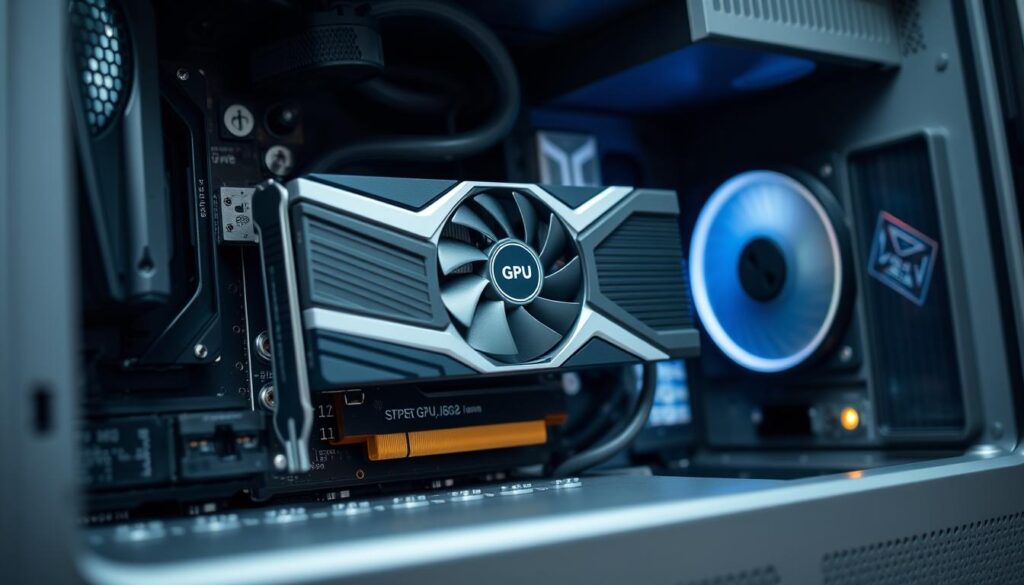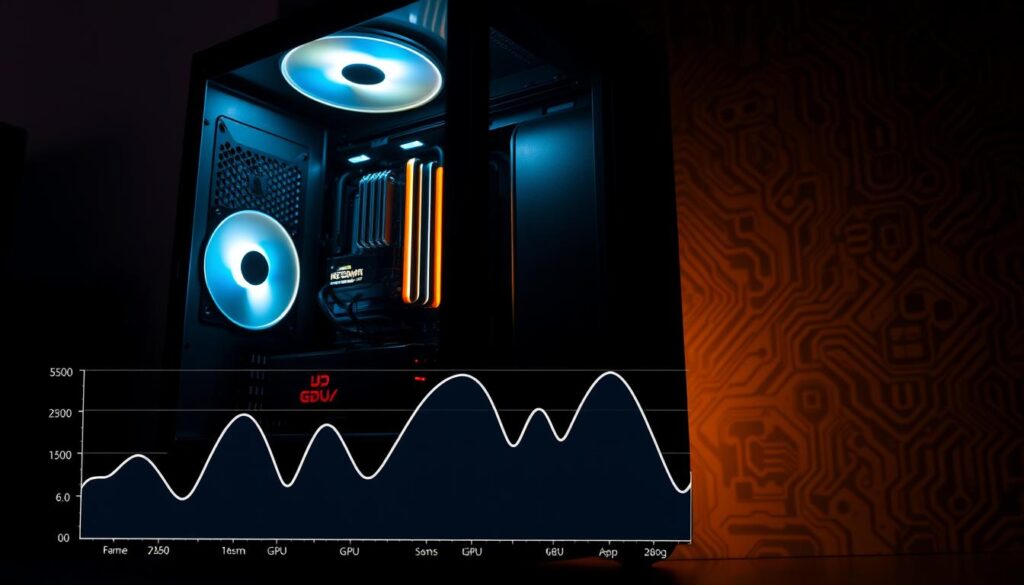Last Updated on August 8, 2025 by Gill
Remember that moment when your favorite game stuttered during a critical battle? Or when your video editing software lagged right before a deadline? These frustrations often trace back to one unsung hero—or villain—in your system: the graphics card. Whether you’re a casual gamer or a creative professional, understanding your machine’s visual capabilities transforms how you interact with technology.
Modern computers rely on two types of graphics processing units: integrated chips for everyday tasks and powerful discrete models for demanding applications. Desktop users often enjoy upgradeable hardware, while laptop owners face more permanent configurations. External solutions now blur these lines, offering flexibility for portable systems.
Identifying your current setup matters more than you might think. Performance in graphics-heavy software hinges on these details, affecting everything from rendering speeds to display quality. Upgrading without this knowledge risks wasted investments or compatibility headaches.
Fortunately, discovering your hardware specs doesn’t require opening your machine or technical expertise. Built-in Windows tools and straightforward methods provide clear answers in seconds. This guide simplifies the process, helping you make informed decisions about game purchases, software use, and future upgrades.
Let’s explore how to uncover these crucial details—no screwdrivers or advanced skills needed. Your journey to optimized visuals starts here.
How to Check What GPU You Have using Windows Task Manager and Device Manager
Windows offers two native methods to reveal your system’s visual powerhouse. Both approaches require zero downloads and deliver instant results—ideal for troubleshooting or upgrading decisions.
Quick Insights via Task Manager
Press Ctrl+Shift+Esc to launch the performance hub. Select the Performance tab and click the GPU section. Here, you’ll spot the model name, active driver version, and live resource usage. Memory allocation percentages show how demanding apps affect your hardware.
Deep Dive with Device Manager
Type “Device Manager” in the Start menu search bar. Expand the Display adapters category to see installed graphics components. Right-click any entry for driver updates or property checks. This menu reveals hardware IDs, driver dates, and potential conflict warnings—critical for diagnosing display issues.
While Task Manager excels at real-time monitoring, Device Manager provides permanent configuration details. Bookmark both methods for future reference when evaluating software requirements or planning upgrades.
Understanding Your GPU Specifications and Model Numbers
Your graphics card’s name holds secrets to its power and capabilities. Manufacturers use coded numbering systems that reveal generation, performance tier, and special features at a glance. Let’s crack these identifiers to make smarter upgrade choices.

Breaking Down Brand Codes
NVIDIA’s RTX 4070 tells a complete story: “RTX” means ray tracing support, “40” marks the generation, and “70” positions it as a high-performance model. Ti or SUPER labels signal upgraded versions within the same family.
AMD’s Radeon RX 7900 XTX follows similar logic. The “7” indicates 7000-series architecture, while “900” places it near the top of that generation. XTX denotes the most powerful variant—like getting a turbocharged engine in your sports car.
Performance Indicators That Matter
VRAM capacity acts as your card’s workspace. Modern games demand 8GB+ for crisp 4K textures, while content creators benefit from 12GB+ when handling complex 3D models. This graphics memory directly impacts how many details your system can juggle simultaneously.
Clock speeds measure how fast your processor crunches visual data. Higher numbers mean quicker rendering, but balance this with thermal limits. Pairing robust cooling with strong clock rates unlocks stable performance for marathon gaming sessions.
Understanding these specs helps predict real-world behavior. A card with ample VRAM but moderate clocks might excel at detailed environments, while a speed-focused model could dominate in fast-paced competitive titles.
Exploring Windows System Settings and DirectX Diagnostic Tool
Windows hides critical hardware insights in plain sight. Two official pathways reveal everything from basic specs to deep diagnostics—perfect for quick checks or thorough troubleshooting.
Accessing Advanced Display Settings
Navigate to System Settings through the Start menu. Choose System > Display, then scroll to “Advanced display” under related settings. This screen lists your active graphics card, current resolution, and refresh rate.
Windows 10 users follow a similar path: Settings > System > Display > Advanced display settings. Both versions show connected monitor details and color profile options. These metrics help optimize visual clarity across devices.
Utilizing the DirectX Diagnostic Tool for GPU Details
Type “dxdiag” into the taskbar search and press Enter. Click the Display tab for a hardware deep dive. The tool reveals driver versions, memory allocation, and detected issues in the Notes section.
This diagnostic utility proves invaluable when verifying software compatibility or resolving glitches. Export the report as a text file for easy sharing with tech support teams.
| Feature | System Settings | DirectX Tool |
|---|---|---|
| Accessibility | 3 clicks | Command-based |
| Key Information | Basic specs & metrics | Driver details & errors |
| Best For | Quick reference | Troubleshooting |
Pair these methods to build a complete hardware profile. System Settings offer snapshot views, while DirectX delivers technical specifics—a powerful combo for informed system management.
Optimizing Your Graphics for Gaming and Performance
Every pixel-packed battlefield and buttery-smooth cutscene relies on smart hardware management. Matching your system’s capabilities with software demands unlocks peak experiences across entertainment and creative workflows.

Game Requirements vs. Hardware Reality
Lightweight titles like Stardew Valley run smoothly on integrated chips. Modern AAA games such as Alan Wake 2 demand discrete graphics cards with 12GB+ VRAM for max settings. Check developer-recommended specs against your GPU’s:
| Game Type | Resolution | VRAM Needed | GPU Examples |
|---|---|---|---|
| Casual/Retro | 1080p | 2-4GB | Intel UHD, AMD Radeon 680M |
| AAA Titles | 1440p | 8-12GB | RTX 4070, RX 7800 XT |
| Competitive Esports | 1080p | 6-8GB | RTX 4060, RX 7600 |
Safe Performance Boosts
Overclocking tools like MSI Afterburner can squeeze extra power from your card. Increase clock speeds gradually while monitoring temperatures—85°C is the danger zone. Stable boosts of 5-10% improve frame rates without hardware strain.
Laptop users face unique constraints. Two machines with identical GPU models might perform differently based on thermal designs and wattage limits. Use cooling pads and optimize power settings for sustained performance during marathon sessions.
Balancing visual quality with smooth gameplay involves tweaking shadow details and anti-aliasing. Reduce these settings first if frames drop below 60 FPS. Pair your graphics card with sufficient RAM and a capable CPU to avoid bottlenecks.
Additional Methods to Verify Your GPU Information
Sometimes, the full story of your system’s visual capabilities requires detective work beyond basic tools. Specialized software and community knowledge fill gaps left by standard diagnostics.
Third-Party Software and Manufacturer Utilities
Programs like GPU-Z and HWiNFO reveal hidden specs—memory type, thermal limits, and voltage details. These tools display real-time sensor data during gaming or rendering tasks, showing how your graphics card handles stress.
Brand-specific apps add another layer. NVIDIA’s Control Panel lists exact model numbers under “System Information,” while AMD Adrenalin shows power tuning options. Laptop users benefit most here—manufacturer utilities clarify performance ceilings caused by thermal designs or wattage restrictions.
Cross-Checking Through Online Communities
Forums like Tom’s Hardware and Reddit’s r/buildapc archive decades of user reports. Search your GPU model to find real-world benchmarks, common issues, and optimization tips. These platforms help decode confusing model numbers from OEM systems.
| Resource Type | Best For | Example |
|---|---|---|
| Diagnostic Software | Technical specifications | GPU-Z memory clocks |
| Brand Utilities | Performance tweaks | NVIDIA Control Panel |
| Community Forums | Real-world usage data | Laptop GPU throttling fixes |
Combining these methods creates a complete hardware profile. Physical inspection remains crucial for warranty claims—sticker details on the card itself often differ from software readings.
Conclusion
Your computer’s visual prowess hinges on understanding its graphical heart. Discovering your system’s capabilities transforms how you play, create, and work—turning guesswork into strategic action.
The graphics card serves as your machine’s artistic engine. Whether verifying specs through built-in tools or third-party software, each method equips you with critical insights. Casual users gain clarity on everyday performance, while enthusiasts unlock upgrade pathways.
Modern software demands evolve faster than ever. Ray tracing and AI-enhanced rendering push hardware limits daily. Regular monitoring ensures your processing components meet these challenges head-on, avoiding lag during crucial moments.
Laptop owners face unique considerations. Integrated chips handle spreadsheets effortlessly, but creative tasks require discrete power. Knowing your exact model helps balance portability with performance needs.
Armed with this knowledge, every decision becomes intentional. Game purchases align with VRAM capacities. Driver updates target specific bottlenecks. Upgrade choices reflect real-world benchmarks rather than marketing hype.
Your machine’s potential lies waiting—these verification techniques are the keys. From casual browsing to competitive gaming, understanding your graphics setup ensures you never settle for less than smooth, vibrant experiences.
FAQ
What’s the fastest way to see my graphics card details on Windows?
How do I decode NVIDIA or AMD model numbers?
Why is VRAM important for gaming?
Can DirectX Diagnostic Tool reveal driver issues?
What third-party apps provide detailed GPU insights?
How do I match my GPU to game requirements?
Is overclocking safe for boosting performance?
- Optimize Your GeForce RTX 5070 Performance with Our Bottleneck Tool - October 2, 2025
- GeForce RTX 5090 Bottleneck Calculator: Optimize Your Setup - October 1, 2025
- GeForce RTX 5080 Bottleneck Calculator: Optimize Your Setup - September 30, 2025











